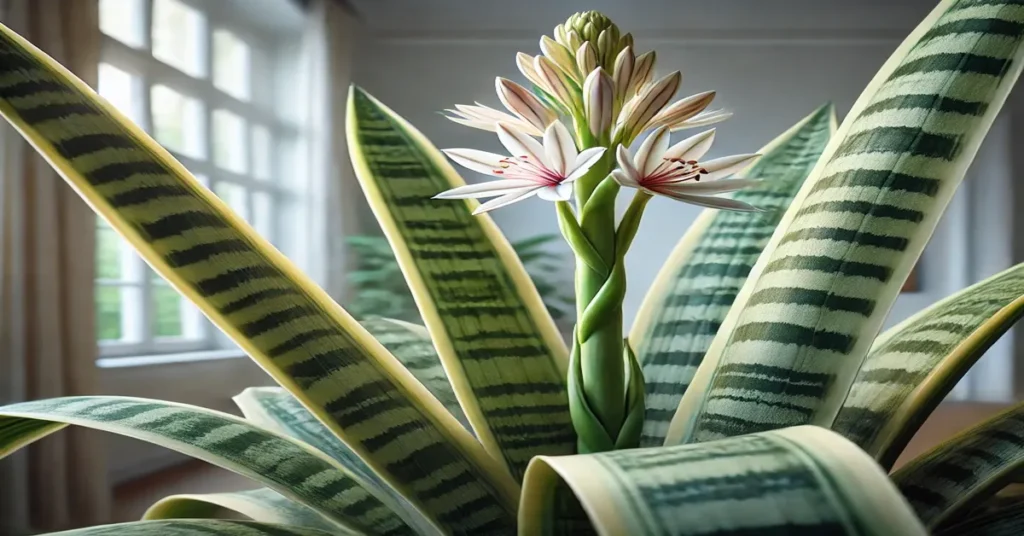The snake plant flower is one of nature’s hidden gems that even seasoned plant lovers find surprising. Known for its sturdy, sword-like leaves and easy care, the snake plant (Dracaena trifasciata) holds a secret few are aware of under the right conditions it can bloom. This rare event transforms an already striking plant into an even more captivating centerpiece. Let’s dive into what makes the snake plant flower unique, how to encourage it to bloom, and why it’s worth the effort.
Snake Plant Flower: What Does It Look Like?
When a snake plant flower finally makes an appearance, it’s a sight to behold. It grows on a tall stalk that shoots up from the base of the plant, sometimes reaching up to three feet in height. The delicate blossoms are typically white or pale green and shaped like tiny trumpets, releasing a sweet fragrance that becomes more pronounced at night. The unexpected elegance of these flowers adds a touch of wonder to your indoor garden.
Why a Snake Plant Flower is So Rare
You might be asking, “Why doesn’t every snake plant flower?” The truth is, blooming isn’t common for snake plants, especially when they’re kept as houseplants. This rarity makes spotting a flower all the more exciting. The factors that encourage blooming include:
- Maturity: Snake plants usually need to be several years old before they have enough energy to flower.
- Bright, Indirect Light: While snake plants can survive in low light, they thrive and are more likely to bloom with bright, indirect sunlight.
- Controlled Stress: Mild stress, such as infrequent watering that mimics the plant’s natural arid habitat, can trigger a bloom.
- Well-Draining Soil: Healthy roots are essential for flowering, and well-draining soil prevents issues like root rot.
Snake Plant Flower: How to Encourage Blooming
If you want your snake plant flower to make its debut, it’s time to pay attention to its environment. Here’s how you can set the stage for a potential bloom:
Let There Be Light
Place your snake plant near a window that receives ample filtered sunlight. While snake plants can tolerate low light, exposure to brighter conditions increases their energy levels, making flowering more likely.
Create Mild Stress
Believe it or not, slight neglect can sometimes work wonders. Infrequent watering that replicates the dry conditions of the snake plant’s native region can push it into blooming mode. Just be sure not to overdo it, as too much stress can harm the plant.
Optimize Soil Conditions
Healthy roots lead to happy plants. Ensure your snake plant is in well-draining soil, ideally a mix formulated for succulents. This keeps the roots from becoming waterlogged and allows the plant to grow robustly enough to support a flower.
The Magic of the Bloom: Why It’s Special
A snake plant flower isn’t just beautiful; it brings a sense of achievement and wonder. The tiny, waxy blossoms often produce a sticky nectar that glistens in the light, adding a touch of mystery. The scent is another surprise—it’s sweet and most potent in the evening, subtly filling a room with a delicate fragrance.
Caring for Your Snake Plant After It Flowers
Once your snake plant flower makes an appearance, it’s essential to maintain good care practices to support the plant’s overall health. Here’s how to nurture your snake plant during and after blooming:
Keep Up the Light
Continue providing bright, indirect light to sustain the plant’s energy levels. Flowering can be taxing, and ample light helps your snake plant recover and grow.
Maintain Your Watering Schedule
Stick to a moderate watering routine. While the plant may need a little more moisture during blooming, avoid overwatering, which could lead to root rot.
Pruning the Flower Stalk
Once the snake plant flower fades, you can cut the stalk at the base using clean pruning shears. This prevents the plant from expending unnecessary energy on a fading flower and helps it focus on leaf growth and overall vitality.
Conclusion
Spotting a snake plant flower is like discovering a hidden gem in your home. While the plant is primarily admired for its resilient, striking foliage, the rare bloom adds an unexpected element of beauty and delight. By understanding the conditions that encourage flowering and maintaining your plant’s health, you increase your chances of witnessing this botanical marvel. Whether or not your snake plant flowers, its ability to thrive with minimal care makes it a valuable and attractive addition to any space.
FAQs
How long does a snake plant flower last?
The bloom typically lasts a few weeks, depending on the care it receives and environmental conditions.
Do all snake plants flower?
No, flowering is relatively rare, especially for indoor snake plants.
Does flowering indicate the plant is healthy?
Yes, blooming usually indicates that the plant is mature and well cared for.
Can I force my snake plant to bloom?
While you can encourage blooming with optimal conditions, there’s no guaranteed way to force it to flower.
Is the snake plant flower fragrant?
Yes, the flower emits a sweet scent, particularly noticeable at night.







